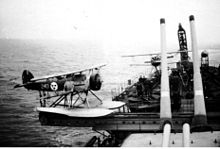Gotland (ship, 1933)
|
The Gotland in the Caribbean in 1938
|
||||||||||||||||||||
|
||||||||||||||||||||
|
||||||||||||||||||||
|
||||||||||||||||||||
|
||||||||||||||||||||
The Gotland was an aircraft cruiser of the Swedish Navy , built from 1930 in the Götaverken in Gothenburg . It should be able to be used as a cruiser, aircraft mothership and mine-layer . Initially, the Gotland was equipped with six seaplanes , four guns and four anti-aircraft guns . From 1944 the ship was used as an anti-aircraft cruiser.
development
The Gotland was originally designed in 1926 as a small aircraft carrier with two catapults and 12 wheeled aircraft that were supposed to land on land. As early as 1927, the concept was modified to an aircraft cruiser, which now provided for 15.2 cm guns in three twin turrets as well as 12 seaplanes and two catapults. Due to the limited financial resources, the concept was revised again: the fuselage was shorter, two of the guns were housed in casemates and a catapult was left for the launch of six aircraft.
Seaplanes
There were six Hawker Osprey on board. The ship had space for eight Hawker Ospreys and attempts were made to buy two more, but this was unsuccessful as production of this type had ceased. The ship was originally supposed to be able to take three more on board if necessary. In such cases, however, the launch catapult could no longer be used. The catapult started the aircraft with compressed air and a speed of 100 km. At the other end of the flight deck there was a lifting crane that was used to lift the aircraft back on board after landing on the water. In practice, it turned out that the aircraft suffered from the effects of high waves in rough weather. This often forced the ship to return to port.
In 1944 the planes were removed and instead eight anti-aircraft guns, six torpedo tubes and a mine-laying device were added.
Mission history
Second World War
During target practice in the Kattegat , on May 20, 1941, she sighted the German battleship Bismarck and the heavy cruiser Prinz Eugen at the start of the Rhine Exercise Company . The Gotland routinely reported the sighting to the Swedish fleet, which ultimately informed the British Admiralty .
post war period
The ship was used as a training ship after the Second World War , decommissioned in 1956 and scrapped in 1963.
literature
- Curt Borgenstam, Per Insulander, Bertil Åhlund: Kryssare: med svenska flottans kryssare under 75 år (1: a) , CB Marinlitteratur, 1993, ISBN 91-970700-68 .
- Robert Gardiner / Roger Chesneau: Conway's All the world's fighting ships 1922-1946 , Conway Maritime Press, London 1980, ISBN 0-8317-0303-2 .
- Siegfried Breyer: Aircraft cruiser aircraft mother ships aircraft tender until 1945 , Podzun-Pallas-Verlag, Wölfersheim-Berstadt, 1994, ISBN 3-7909-0509-7 .
- Jürgen Rohwer , Gerhard Hümmelchen : Chronik des Seekrieges 1939–1945 , edited by the working group for military research and by the library for contemporary history , Manfred Pawlak Verlagsgesellschaft, Herrsching o. J. [1968], ISBN 3-88199-0097 , ( http: // www.wlb-stuttgart.de/seekrieg/chronik.htm extended online version).
Web links
- Gotland light cruiser - seaplane carrier (1934) at navypedia.org, accessed on January 21, 2020


